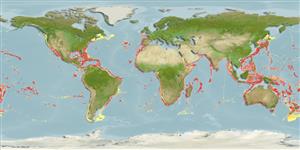Preferred temperature (อ้างอิง
123201): 7 - 14.4, mean 9.9 °C (based on 642 cells).
Phylogenetic diversity index (อ้างอิง
82804): PD
50 = 1.0000 [Uniqueness, from 0.5 = low to 2.0 = high].
Bayesian length-weight: a=0.01202 (0.00608 - 0.02377), b=2.98 (2.80 - 3.16), in cm total length, based on LWR estimates for this species & (Sub)family-body (Ref.
93245).
ระดับชั้นอาหาร (อ้างอิง
69278): 4.3 ±0.67 se; based on food items.
ความสามารถในการกลับคืนสู่ปกติ (อ้างอิง
120179): ต่ำ, เวลาต่ำสุดที่จะทำให้ประชากรเพิ่มขึ้นเป็น 2 เท่าใช้เวลา 4.5 - 14 ปี (Assuming tm=4-5).
Fishing Vulnerability (Ref.
59153): Very high vulnerability (90 of 100).
🛈
Climate Vulnerability (Ref.
125649): Moderate vulnerability (39 of 100).
🛈
Nutrients (Ref.
124155): Calcium = 7.33 [3.81, 15.92] mg/100g; Iron = 0.279 [0.128, 0.578] mg/100g; Protein = 17.1 [14.9, 19.0] %; Omega3 = 0.33 [0.19, 0.60] g/100g; Selenium = 29.2 [12.6, 64.6] μg/100g; VitaminA = 11.8 [2.8, 50.1] μg/100g; Zinc = 0.25 [0.17, 0.37] mg/100g (wet weight);
